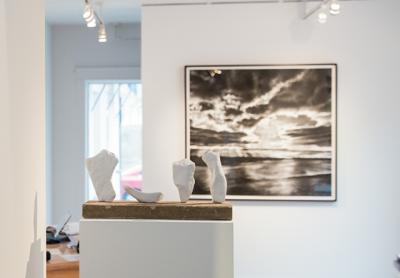‘Black and White’ and Hung All Over

Sometimes you feel like color and sometimes you don’t. Tripoli Patterson, a dealer and collector, said that while color is the primary reason he himself is attracted to an art object, he also seeks to understand what artists and their audiences respond to in a muted or absent palette.
For the past few weeks, “Black and White,” currently on view at his Tripoli Gallery in Southampton, has explored that realm with a diverse cast of artists, both new and familiar to the gallery. Katherine Bernhardt, Ross Bleckner, Quentin Curry, Jamie dePasquale, Tracey Emin, Ryan Estep, Urs Fischer, April Gornik, Takesada Matsutani, Angelbert Metoyer, Ned Smyth, Hiroshi Sugimoto, Igor Vishnyakov, and Darius Yektai contribute works in several mediums, sometimes wildly divergent, yet when placed together, having clear visual relationships.
“The show basically hung itself,” Mr. Patterson said last weekend.
The effect is most apparent in the back gallery, where a transition from paired works by Mr. dePasquale to Mr. Bleckner to Mr. Yektai moves from geometric precision to more gestural work to fully free-form mark-making in cement (which sounds like an oxymoron, but it is indeed what Mr. Yektai achieves).
It is evident in the front room as well, with abstracted references to the human form in the mixed media of Mr. Matsutani, the paintings of Mr. Vishnyakov, and the 3-D prints of Mr. Smyth. “Wave 2004-01,” Mr. Matsutani’s sculptural work on canvas mounted on panel, refers to water yet looks more like skin folds or other bodily forms — a lip cut, or surgical incision. In deep moody gray tones, its finish is both matte and smooth enough to absorb and reflect light.
Mr. Vishnyakov’s “Black and White Nude (0407),” an acrylic on canvas, is more straightforward. It is clearly a painting, and the title encourages the eye to blend its loosely applied light and shadow — what might have been referred to as “sfumato” in another era — into a female torso.
Mr. Smyth’s 3-D prints of his familiar cast and carved sculptural forms all refer to his abstracted representations of the body in different guises throughout art history. In this piece he has gathered up his “Female Torso,” “Cubist Torso,” “Reclining” figure, and “Male Torso” and mounted them on a cement base. He references classical contrapposto nudes in the female torso, which undulates from side to side, much in the way of Botticelli’s “Venus.” The Cubist form looks cut out of a Picasso or Braque painting. The reclining form could refer to Henry Moore or any number of his predecessors. The hulking male torso seems an inheritor of other colossal statues or, more specifically, to the bulky sculptures of Rodin.
Ms. Emin’s sketchy lines, made by embroidery stitches on a wool blanket, resolve into a female form as well, with an uncomfortable exaggeration of splayed legs. Words, stitched at the bottom like an old-fashioned sampler, state plainly that “You made me feel like nothing.” The meaning of the words makes one wonder if the head, which appears to be cast to the side, is actually even there. Is it a face, a mask, or just a black void — i.e., nothing?
Also referencing the figure, in childlike line drawings in acrylic on aluminum, is Mr. Curry. “Always Fishing” includes cats, dogs, mice, birds, people, words, arrows, balloons, cans, peace signs, and much, much more. The elements of his composition emerge and gather into patchy, cloudlike forms created by white and lighter paint on the otherwise black surface. It is reminiscent of what one might see in the quick second before the eyes adjust in a darkened room suddenly illuminated by a lamp.
Except for the reference to a wave in Mr. Matsutani’s work, there is no other landscape, aside from Ms. Gornik’s 2016 “Incandescent. Executed in charcoal on paper, it stands out in moody graphite grayness, a seascape with a stormy sky so cloudy and dark that the sun radiates through, in dramatic fingers of light, down to the water and sand below.
In the same room, and hard to classify, is Mr. Metoyer’s “Portrait” in coal and paint on canvas. A diptych of sorts, the two canvases hang along their sides, so that they project into the gallery and face each other, mere inches apart. It is almost impossible to see what he has painted there; it looks at first like a universe of sorts, until other forms emerge. The stretchers that face outward are coated in black coal and embellished with face masks, one mounted on each, also coated in coal.
With the exception of Mr. dePasquale’s crossword grids, the back room’s abstraction is practically devoid of visual references, although some allude to an inspiration in their titles. Mr. Fischer’s cast bronze and oil paint “Scribbler” could be seen as two embracing forms or just a doodle in the round. Mr. Sugimoto’s “Joe” is a photographic abstraction, all light and shade. More overt in his intention, Mr. Estep’s “Tool P8v1” is his interpretation of a tool used in wheat-threshing.
Mr. Bleckner uses a blowtorch to create the paintings he shows here, looking vaguely like the night sky but not specifically so.
Somewhat of an outlier, but looking correct across from Ms. Emin’s blanket, are Ms. Bernhardt’s simple drawings in acrylic on burlap coffee bags. The series is untitled, but the crude, thick lines portray objects such as a Sharpie ink pen or a watermelon.
Originally scheduled to close Sunday, the show has been extended to April 30.
